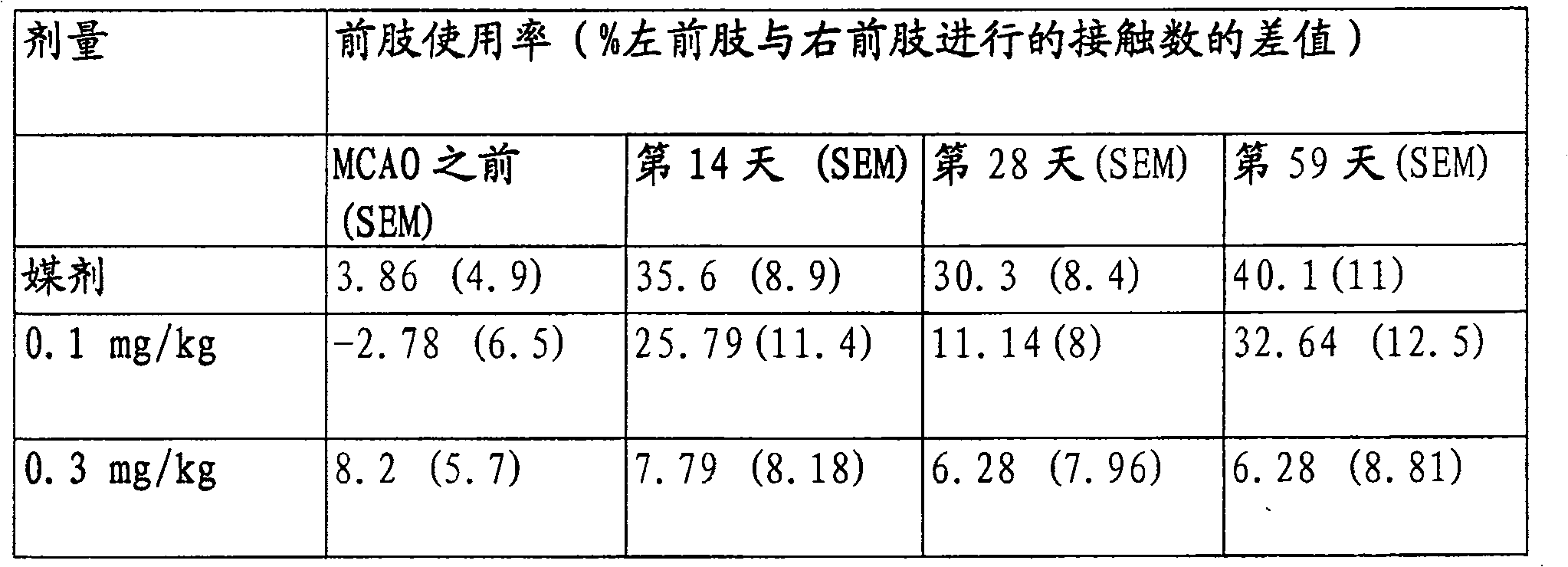Sigma ligands for neuronal regeneration and functional recovery
A neuronal, neurodegenerative technique applied in the field of neuronal regeneration
- Summary
- Abstract
- Description
- Claims
- Application Information
AI Technical Summary
Problems solved by technology
Method used
Image
Examples
example 1
[0119] Animal Models of Neuronal Regeneration (Functional Restoration)
[0120] Male 3-month-old SHR (spontaneously hypertensive) rats were used to induce MCA-occlusive stroke. This is the preferred category since most stroke patients are hypertensive. Animals were anesthetized with Methohexital and a small craniotomy was performed on the zygmotic arch to expose the middle cerebral artery, which was occluded with 10-0 monofilament nylon suture distal to the origin of the striatal branches . Rats were not intubated and no catheters were inserted. Following MCA occlusion, massive and reproducible infarcts were obtained, resulting in a lack of robust sensory activity. Animals were placed on a 6 hour light / 18 hour dark cycle without food or water. Two days after MCAO, rats were treated with Compound I, II, III, IV, V, VI, VII, VIII or IX (0.03-10 mg / kg) s.c. or p.o. and a control group was given saline for 2-8 weeks. Animals were tested at 2, 4, 6 and 8 weeks in either the ...
example 2
[0134] Evidence of nerve regeneration in rats treated with SA4503
[0135] 1. Rotating rod
[0136] Thirty-five spontaneously hypertensive rats were exposed to constant middle cerebral artery occlusion (MCAO) and then divided into three treatment groups. SA4503 was administered s.c. at a dose of 0.3 mg / kg (12 rats) or 1.0 mg / kg (12 rats) starting two days after occlusion and continuing daily up to 28 days after occlusion. In the control group (11 rats), only vehicle was administered. At several time points after the initiation of treatment and during testing, rats were assessed for their ability in the rotarod model. Such a model is described in Example 1. It requires rats to pass through a horizontally suspended rotating rod with a length of 1 m. This task measures the sensory-motor abilities of animals. The behavior of the animals is recorded using video cameras and then analyzed and scored by specially trained technicians. Scores range from 0-6, with 0 indicating the ...
example 3
[0148] Gene Expression Studies
[0149] The Ethics Committee for Animal Research at Lund University approved the protocol. Six-month-old male SHR (550 x 350 x 200 mm, 3 to 4 rats per cage) were housed in standard cages (550 x 350 x 200 mm, 3 to 4 rats per cage) for the first 2 months and before surgery, obtained from Mollegard Breeding Center, Ejby, Denmark. Spontaneously hypertensive rats) were anesthetized intraperitoneally with methohexital sodium (Brietal, 37° C.) 50 mg / kg. The right MCA was assessed via a minicraniotomy and the artery was ligated at the terminal end of the striatal artery to cause neocortical infarction. The average procedure time was about 20 minutes and body temperature was maintained close to 37°C. After surgery, rats were kept in individual cages for 24 hours. Rats subjected to MCA occlusion (MCAO) were transferred to a standard environment (SE), or placed into large, vertical enriched environment (EE) cages (815 x 610 x 1,280 mm) equipped with hor...
PUM
| Property | Measurement | Unit |
|---|---|---|
| length | aaaaa | aaaaa |
Abstract
Description
Claims
Application Information
 Login to View More
Login to View More - R&D
- Intellectual Property
- Life Sciences
- Materials
- Tech Scout
- Unparalleled Data Quality
- Higher Quality Content
- 60% Fewer Hallucinations
Browse by: Latest US Patents, China's latest patents, Technical Efficacy Thesaurus, Application Domain, Technology Topic, Popular Technical Reports.
© 2025 PatSnap. All rights reserved.Legal|Privacy policy|Modern Slavery Act Transparency Statement|Sitemap|About US| Contact US: help@patsnap.com

